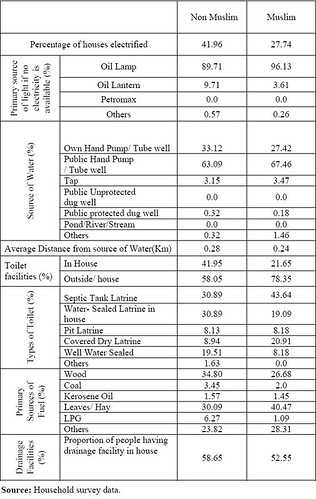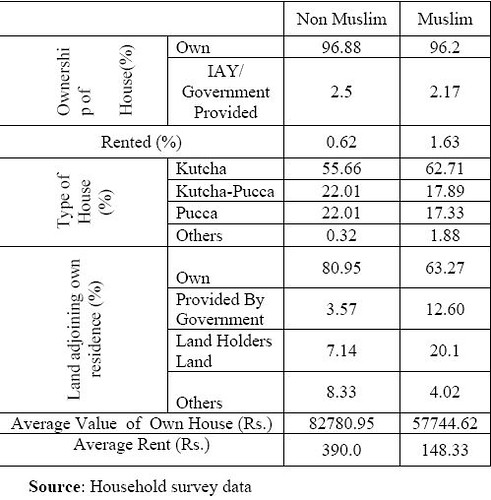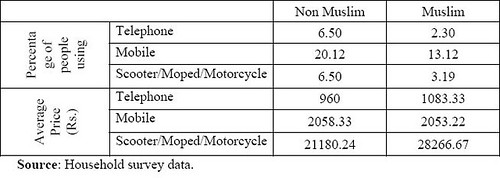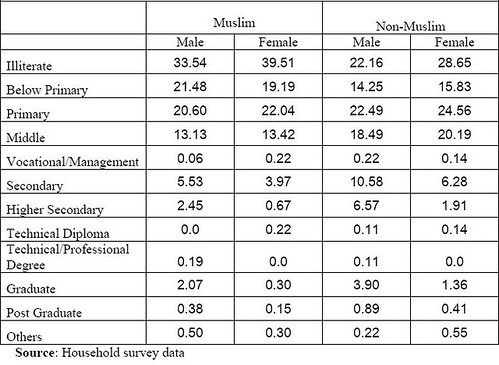From Twocircles
Kolkata: This November, the Sachar Committee Report completed five years of ‘shelf life’. While some debate and more politics on its findings about socio-economic and educational condition of Muslims in the country have been on all these years, a new report has come out with more startling facts about the minority community in West Bengal.
The Centre for Studies in Social Sciences, Calcutta (CSSSC), an autonomous body equally funded by both central and West Bengal government, recently published report of its baseline household survey on the state of Muslims in 12 Minority Concentration Districts (MCDs) of West Bengal. The CSSSC had conducted the household survey in 2008, two years after the Sachar Report made public, with an aim to build on and supplement, wherever necessary, the findings of the Sachar Report to ensure overall growth and development of the MCDs.
People geting weekly food relief from Charity Alliance in Ghoshpara, Murshidabad
The findings of the CSSSC survey could be categorized under the broad headings of: Basic Amenities; Education; Health; Infrastructure; Occupational conditions; Existence and Efficacy of Government Schemes. But before we go into the detail of the findings about each MCD of West Bengal, let’s have a quick look at the summary of the findings.
Summary of CSSSC findings about West Bengal Muslims
1. Most of the Muslims are far behind in literacy, education
2. Dropout rate higher among Muslims than Non-Muslims
3. Electricity, drainage, sanitation facilities less in Muslim areas than non-Muslim areas
4. Muslims are holding most of kuccha houses.
5. Indira Awas Yojana (IAY) provided home to Muslims in negligible number
6. Vocational training of Tailoring is higher among Muslims
7. Muslims need more Technical School.
8. Muslim females engaged in house more than the Non-Muslims
9. Engagement in professional work: Muslims far behind than Non-Muslim
10. Most of the public hospitals are not located in close proximities
11. Child birth at home higher among Muslims
12. Muslims not aware of government projects in village like SGSY, IAY, NREGS, Swajaldhara etc.
Survey in the MCDs
The MCDs in West Bengal are: Uttar Dinajpur, Dakshin Dinajpur, Malda, Murshidabad, Birbhum, Nadia, South 24 Parganas, North 24 Parganas, Bardhaman, Cooch Behar, Haora and Kolkata.
Household survey had not been conducted by the government in West Bengal since long. Throughout the 34 years rule of the Left Front, Muslims demanded such survey, but the state government always rejected. But after the Sachar Report uncovered the truth, the Central Government initiated to conduct the household survey in MCDs of West Bengal. CSSSC was asked to conduct the survey.
The CSSSC team was headed by renowned economist Prof Sugata Marjit while other members were Prof. Partha Chatterjee, Dr. Pranab Kumar Das, Dr. Sohel Firdos, Dr. Saibal Kar and Dr. Surajit C. Mukhopadhyay. The team also sought cooperation from several Central & State Government departments like National Sample Survey Organisation (Kolkata), Minority Affairs & Madrasah Education Department of West Bengal, West Bengal Minorities Development & Finance Corporation besides District Magistrate of each MCD.
The CSSSC survey covered 30-50 villages in each MCD as a pilot project: 30 villages of 10 blocks in Cooch Behar; 30 villages of 17 blocks in Murshidabad; 29 villages of 11 blocks in Malda; 30 villages of 7 blocks in Dakshin Dinajpur; 28 villages of 8 blocks in Uttar Dinajpur; 29 villages of 21 blocks in South 24 Parganas; 30 villages of 18 blocks in North 24 Parganas; 30 villages of 20 blocks in Bardhaman and 30 villages of16 blocks in Birbhum district.
Demography of MCDs
Murshidabad is classified as ‘A’ category district of this project for which both the sets of religion specific socio-economic and basic amenities indicators are below the respective national averages with the values being 35.4 and 17.8. Muslims share 63.72% population (as per Census 2001).
Uttar Dinajpur as Muslim minority district belongs to category ‘A’ of the MCD districts with 47.36% Muslim population and religion specific average socio-economic indicator value 29.7 and average basic indicator value 9.2. The SC and ST population of the district are 27.71% and 5.11% respectively.
Dakshin Dinajpur as Muslim minority district belongs to category ‘A’ of the MCD districts with 24.02% Muslim population and religion specific average socio-economic indicator value 44.9 and average basic indicator value 11.6.
Malda is marked as Muslim minority district and belongs to category ‘A’ of the MCD districts with 49.72% Muslim population and religion specific average indicator value 38.2% and average basic indicator value 16.2%. The minority population is roughly about 51% while the Hindus constitute 49% of the total population.
South 24 Parganas as Muslim minority district belongs to category ‘A’ of the MCD districts with 33.24% Muslim population and religion specific average socio-economic indicator value 36.6 and average basic indicator value 21.2.
North 24 Parganas as Muslim minority district belongs to category ‘B’ (sub-category B1) of the MCD districts with 24.22% Muslim population and religion specific average socio-economic indicator value 40.9 and average basic indicator value 47.2.
Birbhum as Muslim minority district and belongs to category ‘A’ of the MCD districts with 35.08% Muslim population and religion specific average socio-economic indicator value 38.7% and average basic indicator value 16.9%.
Nadia as Muslim minority district belongs to category ‘A’ of the MCD districts with 25.4% Muslim population and religion specific average socio-economic indicator
value 35.3 and average basic indicator value 24.
Haorah as Muslim minority district and belongs to category ‘B’ (subcategory B1) of the MCD districts with 24.4% Muslim population and religion specific average socio-economic indicator value 41.6 and average basic indicator value 47.4.
Cooch Behar as Muslim minority district belongs to category ‘A’ of the MCD districts with 23.34% Muslim population and religion specific average socio-economic indicator value 40.2 and average basic indicator value 10.49.
Bardhaman is a Muslim minority district for this project and belongs to category ‘A’ of the MCD districts with 20.36% Muslim population and religion specific average socio-economic indicator value 43.2% and average basic indicator value 35.52%.
Basic Amenities in MCDs
As for basic amenities, the CSSSC found Muslim households far below than those of non-Muslims. Whether you talk about in-house toilet, pucca houses or electrification, more Muslim houses have no such facilities compared to the majority community. Not only this, government schemes also bypass Muslims, like Indira Awas Yojna. More non-Muslims have got benefited from the IAY than Muslims, found the survey.

Murshidabad: Basic Amenities of Household – District Averages
Murshidabad: Among Non-Muslim sample households about 96.88 percent have ownership of houses and in case of Muslim households the number is 96.2 percent but a large number of households do not have in-house toilet facility. Pucca houses provided by IAY/Government, is roughly 2.5 percent for Non-Muslim and 2.17 percent for Muslims across district.
Some 27.74 percent of Muslim sample households have electricity connection whereas about 41.96 percent Non-Muslim sample houses are electrified. Kutcha House 55.66 of Non-Muslim and 62.71 of Muslims.
Uttar Dinajpur: The level of average electrification in the Muslim households is marginally lower at 22.1% compared to 26.67% for non-Muslim households. Once again at the village level, Bara Damodarpur, Birnakundi, Soshilapor, Narayantola, Pardha, Damdalia and Bishnupur report zero or very low percentage. 21.62% Muslim households on average have in-house toilet facilities compared to 37.38% for non-Muslim households.

Murshidabad: Housing, Ownership, Type and Value – District Average
Dakshin Dinajpur: Some 12.79% Muslim households on average have in-house toilet facilities compared to 22.41% for non-Muslim households. Percentage of houses electrified of Muslim houses higher than Non-Muslim, 33.46% for Muslim and 19.55% for Non-Muslim. But in-house Toilet position is very bad of Muslim, only 12.79% in Muslim houses and 22.41% in Non-Muslim houses. Majority of the villages have kutcha houses and although 94.76% of Muslim and 95.0% of non-Muslim households own their houses, only 3.37% of Muslim and a little higher 3.82% of Non-Muslim received it under IAY.
Malda: Pucca houses provided under the IAY, is 1.49 percent for Muslims and 2.98 percent for Non-Muslim. Kutcha House larger than Non-Muslim. Kutcha house of Muslim 73.42 percent & Non-Muslim 59.3 percent. Telephone connection 0.83percent of Muslim and 9.11percent of Non-Muslim.
South 24 Parganas: Some 46.74% Muslim households on average have in-house toilet facilities compared to 53.42% for non-Muslim households. 33.26 percent house of Muslim electrified and 40.31 percent electrified Non-Muslim Houses. Some villages are non-electrified. IAY provided house 1.98 percent to Muslim and 0.88 to Non-Muslim. Kutcha House 60.61 percent of Muslim and 46.85 percent Non-Muslim.

Murshidabad: Other Amenities of Household
North 24 Parganas: Percentage of electrified Muslim houses is 49.74 and Non-Muslim 57.82. Kutcha house percentage very close to Muslim and Non-Muslim, but Pucca houses of Muslim too lower than Non-Muslim -- 16.58 percent for Muslims and 25.89 for Non-Muslims. Muslim Motorcycle owner percentage higher than Non-Muslim. Muslim holding 6.94%, Non-Muslim 5.51%.
Birbhum: The district averages for in-house toilet facilities are 14.02% for Muslims and 15.07% for non-Muslims. Electrification of houses is very similar across communities, 28.18% for Muslims and 29.14% for non-Muslims. Muslims or non-Muslims ‘owned’ larger percentage of these houses are kutcha – 81.65% for Muslims and 79.65% for non-Muslims. The pucca houses provided under the IAY, is slightly higher for non-Muslims – 3.30 percent than the Muslims –1.22 percent.
Nadia: Some 47% Muslim households on average have in-house toilet facilities compared to 74 % on non-Muslim households. The level of average electrification in the Muslim households is appallingly low at 24 % compared to 37 % for non-Muslim households. Majority of the villages have kutcha houses and although 92% of Muslim and 97% of non-Muslim households own their houses, only 6.65 % of the former and a meager 1.55% of the latter received it under the IAY.
Haorah: The level of average electrification in the Muslim households is appallingly low at 68.28% compared to 80.99 % for non-Muslim households. Drainage facility in house of Muslim is 39.22% and Non-Muslim 48.25%. Use of LPG is very limited though it is strikingly low among the Muslim community (1.94% for Muslims as opposed to 6.99% for non-Muslims). Under the IAY Muslim houses 0.32% and Non-Muslim 0.69%.
Cooch Behar: Some 43% Muslim households on average have in-house toilet facilities compared to 53.64% for non-Muslim households. Percentage of houses electrified of Muslim 6.31% and Non-Muslim 14.61%. A mere 4.89 % of the Muslims and 4.71% of non-Muslims have received government help for construction of houses under different schemes including IAY.
Bardhaman: The level of average electrification in the Muslim households is appallingly low at 37.67% compared to 46.82 % for non-Muslim households. Kutcha houses 62.5% of Muslim and 59.66% of non-Muslim households. IAY or other poject given to Muslim 1.4% and 3.27%.
Education in MCDs
Murshidabad: In Murshidabad household survey data shows that about 43 percent of Muslim (sum of male and female) and 47 percent of Non Muslim sample population attend primary school but only about 3 percent of Muslim and 8 percent Non Muslim population completes higher secondary. About 2% of the Muslim sample households are graduates whereas 5% of the Non Muslim households have completed graduation. About 46% of Non Muslim sample population has diploma certificates in vocational education whereas no Muslim sample population holds diploma certificate. Dropout rate of Muslim too higher than Non-Muslim. Upto Primary Muslim Male dropout rate 30%, where Non-Muslim Male only 9.52%, beside this female Muslim dropout rate closed to them, Mulim female 12.5% and Non-Muslim 11.11.

Murshidabad: Level of Education – General Population (in percentage)
Uttar Dinajpur: The level of illiteracy among Muslim households that stands at 48.63% for the male and 56.84% for the female. Of the rest who are deemed literate, the percentage of below primary educated male is 21.72 and female 20.77 and the percentage steadily dwindles as one goes higher up till the secondary level (Male 3.43% and Female 1.95%). Dropout rate of Muslim upto Primary 32% (Male) and 59.26% (Female), but Non-Muslim 28.13% (Male) and 43.75 (female). Upto class Eight dropout percentage of Muslim female too high, 81.48%, but Non-Muslim only 68.75%.
Dakshin Dinajpur: Illiteracy among Muslim households that stands at 48.63% for the male and 56.84% for the female. But Non-Muslim 44.10% (male), 58.39% (female). Below primary Muslim 21.72% (male), 20.77% (female). But Non-muslim 20.90% (male), 17.99% (female). Dropout rate upto primary of Muslim 32% (male), 59.26% (female). Non-Muslim 28.13% (male), 43.75 (female).

Murshidabad: Dropout from School – Community wise District Averages
Malda: Illiteracy of Muslim women lower than Non-Muslim. Where Muslim male Illiteracy rate 50.29%, Non-Muslim 47.46%, there Muslim women Illiteracy rate 53.55, Non-Muslim women 57.91%. Dropout rate satisfactory than Non-Muslim. Upto Primary dropout rate both 33% Muslim male & female, but Non-Muslim rate 51.43% for Male and 65.22% for female. Upto class Eight Muslim male dropout rate higher than Muslim female, 77.78% (Male) & 60% (female). Beside this Non-Muslim rate 85.71% (Male) & 95.65% (female).
South 24 Parganas: Illiteracy among Muslim households that stands at 26.77 % for the male and 34.9 % for the female. Of the rest who are deemed literate, the percentage of below primary educated male is 31.88 and female 28.54 and the percentage steadily dwindles as one goes higher up till the secondary level (Male 4.04 % and Female 2.85 %). The situation is not appreciably better for non-Muslim households, where literacy level is certainly higher below primary 18.56% (Male), 28.49 (Female), but secondary school educated of male is 7.88 % and female, 6.87 %. Dropout rate on average 42.31% of Males and 42.19% of females among the Muslim upto primary and Non-Muslim 44.44% (Male) & 17.39% (female).

Murshidabad: Vocational Education – Community wise District Averages
North 24 Pargansas: Percentage of Average Motorcycle/illiteracy among Muslim households that stands at 23.1% for the male and 24.86% for the female. Of the rest who are deemed literate, the percentage of below primary educated male is 25.66 and female 24.29 and in Primary 27.39% (Male), 27.92% (Female). But in the secondary level it is lower (Male 4.13% and Female 4.88%). The situation is for non-Muslim households in secondary, where literacy level is certainly higher male is 8.96 and female, 6.48., but below primary 21.76% (Male) & 24.38% (female) and in primary 25.61% (male), 25.02 (female). Dropout rate upto primary for Muslim 15.22% (male), 30% (Female), but non-Muslim 12% (male), 17.65% (Female). In Vocational training Muslims are ahead than Non-muslim. Muslim 56.41% in this training & Non-Muslim only 11.9%.
Birbhum: Illiteracy of this district Muslim & Non-Muslim in same row in Primary level. Muslim Illiteracy 28.44% (male), 42.03 (female) and Non-Muslim 28.95% (Male), 39.84% (female). In primary level Muslim 23.02& (male), 22.24 (female)and Non-Muslim are lower, 19.37% (male), 20.08% (female). Also same in higher secondary, Muslim 3.33% (male), 0.77% (female), but Non-Muslim 2.98% (male), 0.96% (female). Dropout rate upto primary for Muslim 52.08% (male), 26.67% (female) and Non-Muslim 50% (male), 35.71% (female).
Nadia: Illiteracy among Muslim households that stands at 43.94% for the male and 45.48% for the female. the percentage of below primary educated male is 22.65 and female 21.56 and the percentage steadily dwindles as one goes higher up till the secondary level (Male 3.06% and Female 1.53%). The situation is not appreciably better for non-Muslim households, below primary 22.14% (male), 22.06% (female).where literacy level is certainly higher, but secondary school going percentage for male is 6.88 and female, 4.06. Dropout rate of Muslim higher than Non-muslim. Upto primary Muslim 36.17% (male), 27.27% (female) and non-muslim 20% (male), 21.74% (female). Upto class eight Muslim female dropout rate too high. Muslim 87.23% (male), 95.45 (feale). But for Non-Muslim 82.5% (male), 43.48% (female).
Haorah: Illiteracy among Muslim households that stands at 17.29% for the male and 22.76% for the female. percentage of primary educated male is 32.07 and female 29.74 and the percentage secondary level Male 1.39% and Female 1.18%, higher secondary ;level is too poor 1.39% (male), 1.18% (female). Non-Muslim household behind the Muslim. Though illiteracy rate lower (10.67% male, 16.5% female), but in primary 20.77% (male), 18.51% (female) and higher secondary level 12.85% (male), 5.53% (female). Dropout rate of Muslim too high upto primary level 48.89% (male), 29.41% (female). But for Non-Muslim 24% (male), 35.71% (female). Upto class eight Muslim dropout rate 91.11% (male), 79.41% (female). But non-muslim 80% (male), 85.71% (female).
Cooch Behar: Illiteracy among Muslim households that stands at 42.82% for the male and 42.27% for the female. Non-Muslim 27.21% (male), 35.84% (female). Below primary educated of Muslim male is 20.43 and female 23.03. Non-Muslim 22.04% (male), 20.38% (female). Dropout rate upto primary of Muslim 27.27% (male), 14.29% (female) and Non-Muslim 21.05% (male), 27.27 (female).
Bardhaman: Illiteracy of Muslim percentage 25.75% (male), 37.20% (female) and Non-Muslim 21.78% (male), 34.29% (female). Below primary Muslims percentage higher than Non-Muslim. Muslim 26.54% (male), 24.73% (female), but Non-Muslim 21.48% (male), 21.06% (female). Dropout rate upto primary Muslim percentage lower than Non-Muslim. Muslim 36.67% (male), 33.33% (female) and Non-Muslim 38.46% (male), 31.03% (female).















